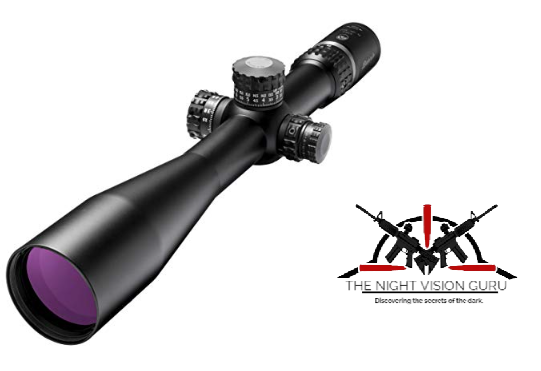TheNightVisionGuru.com is a participant in the Amazon Services LLC Associates Program, an affiliate advertising program designed to provide a means for sites to earn advertising fees by advertising and linking to Amazon.com. Read more.
Do you want to learn how to use a mil-dot scope? You are in the right place.
Mil-dot scopes are versatile tools that offer a multitude of functionalities, honed into a fairly simple layout. This article focuses on mil-dot reticles, providing a guide on how to best use them to your advantage. We start by explaining the basics and then dive deeper into their practical applications.
How to Use a Mil-Dot Scope
1) Understanding Mil
 A mil-dot reticle is characterized by dots, .2 mil in diameter, with a one mil gap between them. The distance between the dots, as well as their size, can help you quickly adjust your aim based on the target’s distance and wind speed. However, not all scopes advertised as “mil-dot” are standard, so ensure you test your scope against known distances and sizes.
A mil-dot reticle is characterized by dots, .2 mil in diameter, with a one mil gap between them. The distance between the dots, as well as their size, can help you quickly adjust your aim based on the target’s distance and wind speed. However, not all scopes advertised as “mil-dot” are standard, so ensure you test your scope against known distances and sizes.
So, what is a mil? A mil, or milliradian, is not a linear measurement like millimeters or centimeters but an angular one. Mils and MOAs (Minute of Angle) are used instead of linear measurements, allowing easy adaptation of your scope across varying distances. One mil translates into different distances depending on the target’s distance: at 100 yards, 1 mil equals about 3.6 inches; at 200 yards, 7.2 inches; and at 1000 yards, 36 inches.
2) The Role of Magnification
 Your mil-dot reticle’s accuracy relies heavily on a specific magnification. Most mil-dot scopes have their “true” setting at 10x magnification. This fact becomes important when you zoom, as most scopes (using Second Focal Plane reticles) do not enlarge the reticle with the image. Therefore, your mil-dot reticle can only accurately represent the corresponding distance at a single point in the magnification range.
Your mil-dot reticle’s accuracy relies heavily on a specific magnification. Most mil-dot scopes have their “true” setting at 10x magnification. This fact becomes important when you zoom, as most scopes (using Second Focal Plane reticles) do not enlarge the reticle with the image. Therefore, your mil-dot reticle can only accurately represent the corresponding distance at a single point in the magnification range.
However, with First Focal Plane (FFP) reticles, the reticle adjusts with the zoom, maintaining accuracy across magnifications. This flexibility is useful, especially when calculating holdovers within 100 yards, a feat that is challenging with Second Focal Plane (SFP) reticles.
3) Rangefinding with Mil-Dot Reticles
 Mil-dot reticles can also be used for rangefinding. By knowing the height or width of your target, you can estimate its range. For example, an average adult coyote is between 21 and 24 inches tall. So, at 100 yards, the coyote should appear between 6 and 6.5 mils tall. Using the following equation: (Known target size x 27.77)/size in mils, you can calculate the approximate distance of the target.
Mil-dot reticles can also be used for rangefinding. By knowing the height or width of your target, you can estimate its range. For example, an average adult coyote is between 21 and 24 inches tall. So, at 100 yards, the coyote should appear between 6 and 6.5 mils tall. Using the following equation: (Known target size x 27.77)/size in mils, you can calculate the approximate distance of the target.
4) Making Adjustments with a Mil-Dot Scope
 Understanding the principles of mils and magnification helps you perform holdovers and adjust your aim for distance and elevation. You will still need a dope card or thorough knowledge of your load to account for bullet drop at certain distances. A mil-dot reticle can facilitate quick on-the-fly adjustments but cannot replace this knowledge.
Understanding the principles of mils and magnification helps you perform holdovers and adjust your aim for distance and elevation. You will still need a dope card or thorough knowledge of your load to account for bullet drop at certain distances. A mil-dot reticle can facilitate quick on-the-fly adjustments but cannot replace this knowledge.
Mil-dot reticles also offer advantages for windage holds, accommodating for wind speed variances. However, you must know how your load reacts to wind across various distances and speeds, which a mil-dot reticle alone cannot provide.
Finally, you can also make adjustments using the windage and elevation turrets on your riflescope, often combined with reticle holds. Remember to return to your zero after adjusting for specific shots.
Frequently Asked Questions
1) What Are Mil-Dot Values?
Standard values on a mil-dot reticle include a 1 mil gap between dots and a dot width of .2 mil. However, these can vary, so ensure to test your scope.
2) Is Mil or MOA Better?
Neither is superior. While MOA allows for greater precision at longer distances, both systems are practical, and skilled shooters can easily switch between them.
3) How Many Inches Is a Mil-Dot?
At 100 yards, a standard .2 mil dot is .72 inches, and at 1000 yards, it would be 7.2 inches. These measurements change based on the target’s distance.
Conclusion
Mil-dot reticles offer a balance of simplicity and versatility that every shooter can benefit from. They can take some time to master, but they will improve your shooting skills in the long run. Whether you stick to the mil-dot reticle or explore other options, the knowledge you gain from using it will undoubtedly make you a more informed and skilled shooter.

